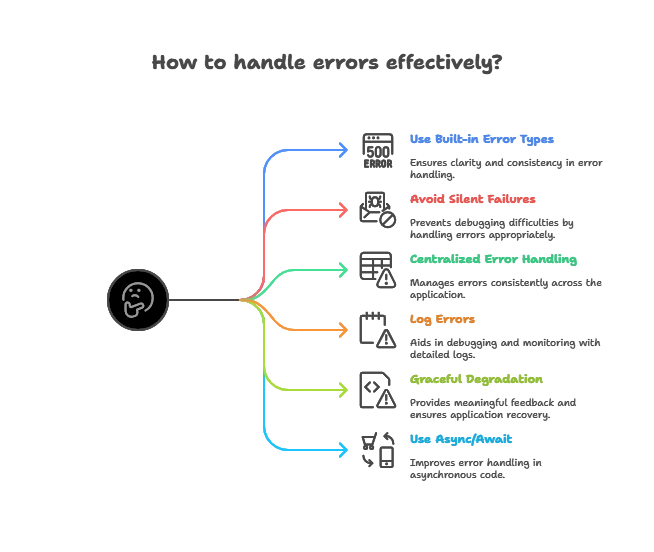Node.js Error Handling
Error handling is a crucial aspect of software development, ensuring that applications can gracefully handle unexpected conditions and provide meaningful feedback to users and developers. In Node.js, effective error handling is vital for building robust, reliable, and maintainable applications. This chapter will guide you through the basics to advanced techniques of error handling in Node.js, covering best practices, common pitfalls, and practical examples.
Understanding Errors in Node.js
Types of Errors
Syntax Errors: These occur during the parsing of code and prevent the code from executing.
// Syntax Error Example
console.log("Hello World;
// Output: SyntaxError: missing ) after argument list
Runtime Errors: These occur during the execution of code and can be caught using try-catch blocks.
// Runtime Error Example
const x = y + 1;
// Output: ReferenceError: y is not defined
Logical Errors: These are mistakes in the logic of the code and do not throw exceptions but produce incorrect results.
// Logical Error Example
const add = (a, b) => a - b;
console.log(add(5, 3)); // Output: 2 (instead of 8)
Basic Error Handling with Try-Catch
The try-catch statement is the most fundamental way to handle errors in JavaScript and Node.js. It allows you to catch and handle exceptions that occur within a block of code.
try {
// Code that may throw an error
const result = JSON.parse('{"name": "John"}');
console.log(result.name); // John
} catch (error) {
// Code to handle the error
console.error('An error occurred:', error.message);
}
// Output: John
Throwing Custom Errors
You can create and throw your custom errors to provide more meaningful error messages and better control over error handling.
function validateAge(age) {
if (age < 0) {
throw new Error('Age cannot be negative');
}
return true;
}
try {
validateAge(-5);
} catch (error) {
console.error(error.message); // Output: Age cannot be negative
}
Error Handling in Asynchronous Code
Callbacks
Error handling in callback-based asynchronous code typically follows the error-first callback pattern, where the first argument of the callback is an error object (if an error occurred) or null (if no error occurred).
const fs = require('fs');
fs.readFile('nonexistent.txt', 'utf8', (err, data) => {
if (err) {
console.error('An error occurred:', err.message);
return;
}
console.log(data);
});
// Output: An error occurred: ENOENT: no such file or directory, open 'nonexistent.txt'
Promises
Promises provide a more elegant way to handle asynchronous operations and errors. The .catch() method is used to handle errors in promises.
const fs = require('fs').promises;
fs.readFile('nonexistent.txt', 'utf8')
.then(data => {
console.log(data);
})
.catch(err => {
console.error('An error occurred:', err.message);
});
// Output: An error occurred: ENOENT: no such file or directory, open 'nonexistent.txt'
Async/Await
Async/await syntax allows you to write asynchronous code that looks synchronous, making it easier to handle errors using try-catch blocks.
const fs = require('fs').promises;
async function readFile() {
try {
const data = await fs.readFile('nonexistent.txt', 'utf8');
console.log(data);
} catch (err) {
console.error('An error occurred:', err.message);
}
}
readFile();
// Output: An error occurred: ENOENT: no such file or directory, open 'nonexistent.txt'
Error Handling in Express.js
Express.js, a popular Node.js web framework, provides mechanisms for handling errors in web applications.
Basic Error Handling Middleware
In Express.js, you can define error-handling middleware functions to catch and handle errors.
const express = require('express');
const app = express();
app.get('/', (req, res) => {
throw new Error('Something went wrong');
});
app.use((err, req, res, next) => {
console.error(err.message);
res.status(500).send('Internal Server Error');
});
app.listen(3000, () => {
console.log('Server is running on port 3000');
});
// Output: Server is running on port 3000
// When accessing '/', the response will be "Internal Server Error" and the error message will be logged to the console.
Custom Error Classes
Creating custom error classes can help in providing more specific error information.
class NotFoundError extends Error {
constructor(message) {
super(message);
this.name = 'NotFoundError';
this.statusCode = 404;
}
}
app.get('/', (req, res) => {
throw new NotFoundError('Resource not found');
});
app.use((err, req, res, next) => {
console.error(err.message);
res.status(err.statusCode || 500).send(err.message);
});
app.listen(3000, () => {
console.log('Server is running on port 3000');
});
// Output: Server is running on port 3000
// When accessing '/', the response will be "Resource not found" with a 404 status code.
Best Practices for Error Handling
Use Built-in Error Types: Utilize built-in error types like
Error,TypeError,SyntaxError, etc., to ensure clarity.Avoid Silent Failures: Always handle errors appropriately to avoid silent failures which can make debugging difficult.
Centralized Error Handling: Implement a centralized error-handling mechanism to manage errors consistently across the application.
Log Errors: Log errors with sufficient details to aid in debugging and monitoring.
Graceful Degradation: Provide meaningful feedback to users and ensure the application can recover from errors gracefully.
Use Async/Await for Asynchronous Code: Prefer async/await syntax for cleaner and more manageable error handling in asynchronous code.

Effective error handling in Node.js is essential for building robust, reliable, and maintainable applications. By understanding the various types of errors, using proper error-handling techniques, and following best practices, you can ensure that your Node.js applications handle errors gracefully and provide a better experience for users and developers alike.Happy coding !❤️
